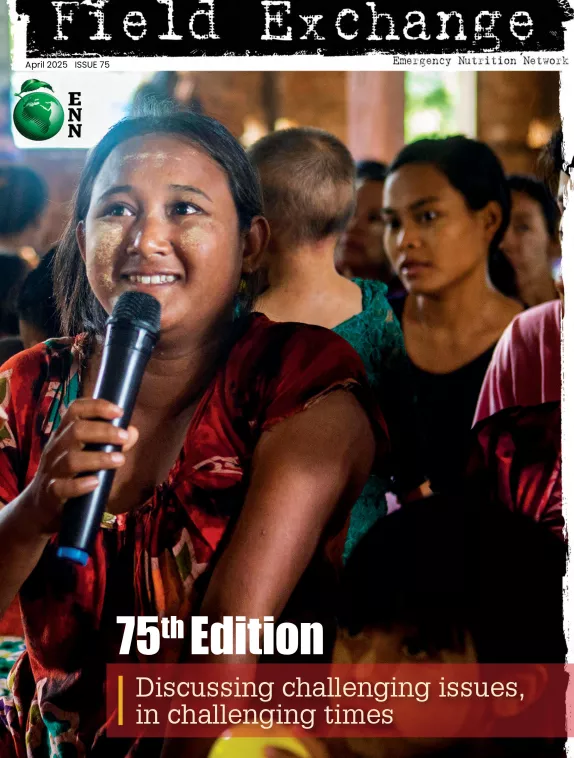The epicentre of the global wasting crisis lies in South Asia: there are more than double the number of wasted (25.1 million) and severely wasted (7.7 million) children in South Asia than in sub-Saharan Africa, the second highest region. Yet, there has been little progress in reducing the prevalence of child wasting in the region to date and coverage of wasting treatment remains less than 5%. Addressing the huge burden of child wasting in South Asia should be a global priority.
That is why we’ve dedicated this special issue of Field Exchange to spotlight this problem, to examine why the burden is so high and to help identify priorities and actions through the learning and reflections of regional and country practitioners and researchers.
The original articles are complemented by soundbites and podcasts from national authors, researchers and Victor Aguayo, Chief of Nutrition, UNICEF HQ.
Editorials

Briefing note on child wasting in South Asia (FEX 63)

Editorial
Original articles

Concordance between weight-for-height z-score (WHZ) and mid-upper arm circumference (MUAC) for the detection of wasting among children in Bangladesh host communities

Previous FEX articles of relevance for wasting in South Asia

One UN for nutrition in Afghanistan - Translating global policy into action: A policy shift to tackle wasting

Adaptations to CMAM programming in Cox’s Bazar in the context of the COVID-19 pandemic

Integrating screening for acute malnutrition into the vitamin A supplementation campaign in the Rohingya camps during the COVID-19 pandemic

Delivery of maternal nutrition interventions at scale and mainstreaming into the health system in Bangladesh

Wasting prevention and treatment - central to stunting reduction in Pakistan

Experiences of the Integrated Management of Acute Malnutrition (IMAM) programme in Nepal: from pilot to scale up

Thiamine Deficiency Remains an Urgent Public Health Problem

Development and use of alternative nutrient-dense foods for management of acute malnutrition in India

Community management of acute malnutrition in Rajasthan, India

Integration of essential nutrition interventions into primary healthcare in Pakistan to prevent and treat wasting: A story of change

Prevention of child wasting in Asia: Possible role for multiple micronutrient supplementation in pregnancy

Supporting healthy growth in infants in low-resource settings in Mumbai, India

Managing at risk mothers and infants under six months in India – no time to waste

Integration of management of children with severe acute malnutrition in paediatric inpatient facilities in India
News & Views

WFP win Nobel Peace Prize

UN Global Action Plan (GAP) Framework for Child Wasting and the Asia and Pacific Region

Improving maternal nutrition in South Asia: Implications for child wasting prevention efforts

South Asia and child wasting – unravelling the conundrum

Tackling child wasting: A review of costing tools and an agenda for the future

Nutrition Exchange South Asia issues on maternal nutrition and complementary feeding

South Asia Technical Advisory Group on Wasting
Research snapshots

Child wasting and concurrent stunting in low- and middle-income countries

Wasting in the wider context of undernutrition: An ENN position paper

Impacts of COVID-19 on childhood malnutrition and nutrition-related mortality

Duodenal microbiota in stunted undernourished children with enteropathy

Development of complementary foods for moderately wasted children to improve gut microbiota status

Effect of supplementation during pregnancy and lactation on the nutritional status of infants in Pakistan

Impact on birth weight and child growth of women’s groups with and without transfers of food or cash during pregnancy in Nepal

Causes and consequences of child growth failure in low- and middle-income countries

Early childhood linear growth failure in low- and middle-income countries

Improving women’s nutrition is imperative for the rapid reduction of childhood stunting in South Asia

The effect of the COVID-19 pandemic on the social, economic and health status of low-income populations in India

The link between foetal and childhood nutrition and adult non-communicable disease: lessons from birth cohort studies in India

Maternal profiles and social determinants of severe acute malnutrition among children under five years of age: A case-control study in Nepal

Factors influencing maternal nutrition practices in a large scale maternal, neonatal and child health programme in Bangladesh

Integrating nutrition interventions into an existing maternal, neonatal and child health programme in Bangladesh

Burden of child and maternal malnutrition and trends in states of India 1990-2017

Severe wasting among Indian infants under six months of age

Birthweight and feeding practices are associated with child growth outcomes in South Asia

Factors associated with wasting among children under five years old in South Asia: Implications for action

Aiming higher for maternal and child nutrition in South Asia

Effectiveness of programme approaches to improve the coverage of maternal nutrition interventions in South Asia
Report summaries

Lives upended - how COVID-19 threatens the futures of 600 million South Asian children

Growth faltering in early infancy: highlights from a two-day scientific consultation

Report of the South Asia ‘Stop stunting: Improving Young Children’s Diets’ conference

Report of the South Asia ‘Stop stunting: Power of Maternal Nutrition’ conference

Low birth weight estimates: Levels and trends 2000–2015

Wasting in South Asia: Building the evidence on policy and programme response






